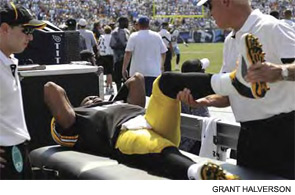Countless football players who have had major joint surgery have returned to the game almost as swift, elusive, and powerful as before their operation. Drew Brees is a recent example, with his shoulder remarkably restored. With the advent of arthroscopic surgery, a player can again play a few weeks after a nip or tuck in the meniscus or loose pieces of cartilage are extracted with the scope. Certainly, many football players have their knees drained of fluid before games or injected with lidocaine or steroids, quick fixes where there is no time for a trip to the operating room during the press of the season.
Of course, with the athlete fixed, temporarily or permanently, he is allowed to return to the exact same activity that caused harm in the first place. Once damaged and out of alignment, a surgically repaired joint is likely to break down under the stress of twisting and pivoting. Repeat injury is common.
While a surgeon can restore the body, should he tell Humpty to climb back on the wall or stay safely on the ground?
During the question-and-answer period at the meeting, I asked one of the speakers, a noted sports medicine expert, why the attitude to musculoskeletal injury in sports differs from that of brain injury. Why, I asked, shouldn’t physicians advocate for new rules, regulations, and even legislation to reduce devastating and debilitating bone and joint injury from football? “Isn’t arthritis serious enough to merit prevention?” I asked.
The surgeon looked surprised by my question because it is contrary to much of sports medicine, the goal of which is to return the athlete quickly to competition. The surgeon replied that the situation with bone and joint injury is different than that of brain injury. Indeed, he said, with strength training, conditioning, pads, and braces, the magnitude of sports-related injury could be reduced.
The orthopedists have their bases covered. If an ounce of prevention does not work, the operating room can provide a pound of cure so that, after going under the knife, the athlete can be as almost as good as new. If I were a surgeon, I would be very proud that a person on whom I operated could again toss a fast ball at 100 miles an hour, smash an overhead, or rocket a 70-yard pass down the field in a perfect spiral.
On the other hand, how would I feel if I knew that a return to sports would increase the likelihood of serious debilitating arthritis in my patient five- or 10-fold and that the eventual outcome would be permanent disability? Would I still recommend or even allow a return to sports? What is the chance of developing arthritis that would make me have a heart-to-heart talk with the athlete and tell him it’s time to say no?

Sports Injuries Exact a Long-Term Toll
Physicians do not like to be scolds, moralists, or spoilsports but, in the case of musculoskeletal injury, the times call for spoilsports. Consider the data. The chance of serious injury in soccer is 1,000 times greater than a high-risk occupation like mining. Remember, mining has special safety programs because of the hazards deep beneath the ground but those risks are a trifling compared to an afternoon on the pitch.

